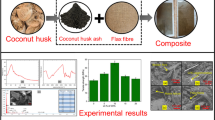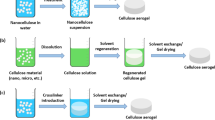Abstract
We have developed a thermocatalytic method for obtaining “Thermocell” microcrystalline cellulose. Our method is simpler than the conventional acid hydrolysis method and allows us to use less concentrated acids at lower temperatures. The microcrystalline cellulose Thermocell has homogeneous granulation and consists of spherical particles, 90% of which have a diameter of 20–50 mm. Depending on the area of application and the required chemical purity, Thermocell can be obtained from bleached or unbleached wood pulp and also wastes of the paper and pulp industry, such as newsprint waste.
Similar content being viewed by others
References
Cellulose in Powdered Form: Annotated Index of the Literature [in Russian], ILIM, Frunze (1987).
C. Vasiliu-Oprea and J. Nicoleanu, “Obtainment and fields of application,” Polymer-Plast. Technol. Eng.,32, No. 2, 181–214 (1993).
O. A. Battista, “Microcrystalline cellulose,” in: Cellulose and Cellulose Derivatives [N. M. Bikales and L. Segal, eds.] [Russian translation], Moscow (1974), Vol. 2, pp. 412–423.
M. G. Laka and M. Ya. Ioelovich, “Changes in the properties of cellulose on thermal treatment,” in: Abstracts of the Fourth Scientific Seminar on the Structure of Wood and Its Role in Delignification Processes [in Russian], Riga (1990), pp. 118–122.
M. G. Laka and M. Ya. Ioelovich. “Kinetic characteristics of the process of thermal aging of cellulose,” in: Abstracts, All-Union Conference on the Chemistry and Reactivity of Cellulose and Cellulose Derivatives [in Russian], Cholpon-Ata (1991), pp. 97–98.
Yu. G. Frolov and A. S. Grodskii, Laboratory Work and Problems in Colloid Chemistry [in Russian], Moscow (1986).
A. V. Obolenskaya, V. P. Shchegolev, G. L. Akim, É. L. Akim, N. L. Kossovich, and I. Z. Emel'yanova, Practical Work in Wood and Cellulose Chemistry [in Russian], Moscow (1965).
M. Ya. Ioelovich, “x-Ray diffraction analysis of cellulose,” in: Cellulose Investigation Methods [in Russian], Riga (1988), pp. 12–15.
British Pharmacopeia (1988), Vol. 1, p. 106.
A. Plonka, “Kryteria oceny wlasciwosci preszkow celulozowych,” Przeglad Papierniczy.,37, No. 3, 228–230 (1981).
“Plastics. Tensile testing methods,” GOST 11262-80. Replaces GOST 11262-76. Moscow (1986). Izmeneniya IUS No. 12, 1991.
“Plastics. Static bend testing methods,” GOST 4648-71. Replaces GOST 4648-63. Moscow (1992). Republished with changes.
B. P. Erykhov, A. I. Naumov, and R. M. Rappoport, “Resonance method for determination of the shear modulus of paper and pulse materials,” Izv. Vyssh. Uchebn. Zaved., Lesnoi Zh., No. 2, 94–98 (1981).
“Fibrous, paper, and cardboard intermediate products. Methods for determination of the breaking stress and tensile elongation.” GOST 13525.1-79. Replaces GOST 13525.1-68. Moscow (1979). Izmeneniya IUS No. 5, 1981 and IUS No. 1, 1985.
Additional information
Institute of Wood Chemistry, Latvian Academy of Sciences, Riga, Latvia LV-1006. Translated from Mekhanika Kompozitnykh Materialov, Vol. 32, No. 4, pp. 549–557, 1996.
Rights and permissions
About this article
Cite this article
Laka, M.G., Chernyavskaya, S.A. Physicomechanical properties of composites containing “thermocell” microcrystalline cellulose as filler. Mech Compos Mater 32, 381–386 (1996). https://doi.org/10.1007/BF02254752
Received:
Issue Date:
DOI: https://doi.org/10.1007/BF02254752




